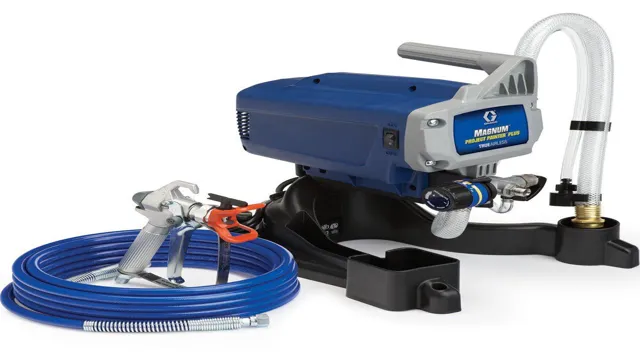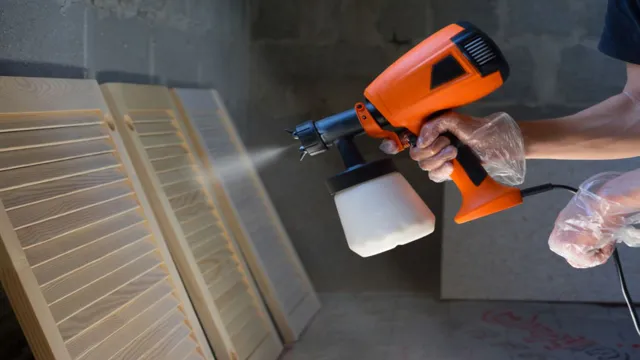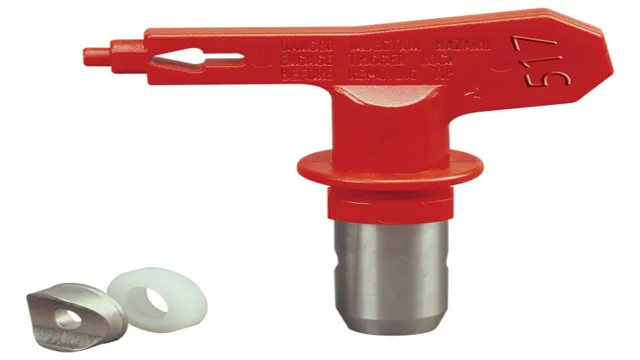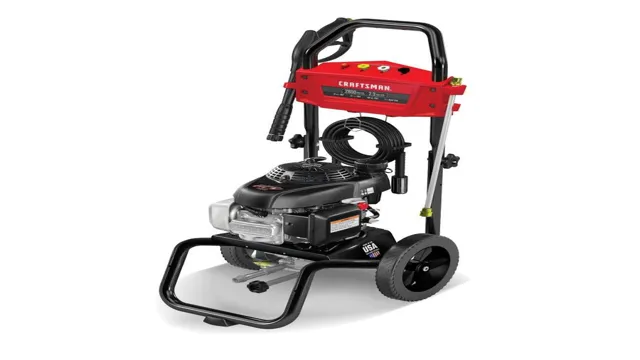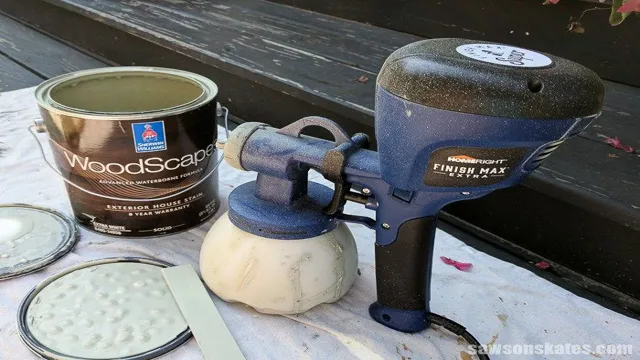Why is Paint Sprayer Spitting: Common Causes and Solutions

Paint sprayers are a great tool for DIY enthusiasts and professionals alike. They offer speed, efficiency, and a smooth finish that’s hard to beat. But what happens when your paint sprayer starts spitting? It can be frustrating to see those little droplets ruining your project, and it’s not always easy to figure out why it’s happening.
In this blog post, we’ll explore some of the common reasons why your paint sprayer might be spitting and what you can do to fix it. From clogged nozzles to incorrect pressure settings, we’ve got you covered. So grab your paint sprayer and let’s get to the bottom of this spitting problem!
Understanding the Problem
Have you ever experienced your paint sprayer spitting during a painting project? It’s a frustrating problem that many DIYers and professionals encounter. There can be many reasons why a paint sprayer spits, but the most common is due to a clogged tip or nozzle. The build-up of paint or debris in the tip of the sprayer can cause the paint to spray unevenly or result in spitting.
This can be easily solved by cleaning the tip and ensuring it is clear of any obstructions. Another reason may be due to the pressure being too high or too low, causing the paint to spit out in an uneven pattern. It’s essential to adjust the pressure according to the type of paint and surface being painted.
Understanding why a paint sprayer spits can prevent the frustration and wasted time and ensure a smooth and even paint job.
Definition of Paint Sprayer Spitting
Paint sprayer spitting can be a frustrating problem that arises during the painting process. This occurs when the paint forms droplets on the surface being painted, resulting in an uneven finish. It can be caused by a number of different factors, including low air pressure, poor paint viscosity, and a clogged spray tip.
One of the most effective ways to prevent paint sprayer spitting is to properly prepare the paint before spraying. This involves ensuring that the paint is properly mixed and strained to remove any impurities. It’s also important to make sure that the spray tip is clean and free of any obstructions.
Another key factor to consider is the air pressure, which should be adjusted according to the type of paint being used. By taking these steps, you can successfully avoid paint sprayer spitting and achieve a smooth, professional-looking finish.

Causes of Paint Sprayer Spitting
Paint sprayer spitting is a common issue that can arise during a painting project. It occurs when the sprayer releases uneven and uncontrolled droplets, ruining the smooth and even finish that you are trying to achieve. One of the main causes of paint sprayer spitting is improper cleaning and maintenance.
If the sprayer is not cleaned regularly or has residue buildup from previous projects, it can cause the paint to clog and not spray correctly. Another cause could be the wrong type of paint viscosity or using old or expired paint. This causes the paint to become too thick or too thin, leading to uneven droplets.
It’s important to know the root of the problem to properly resolve it and achieve a professional-looking paint job. By understanding the causes of paint sprayer spitting and taking preventative measures, such as proper cleaning and using the correct paint viscosity, you can avoid this problem and achieve a smooth, high-quality finish.
Solving the Issue
Paint sprayers are a great tool for DIY enthusiasts and professionals alike, making painting tasks faster and easier. However, sometimes these devices can malfunction and cause issues such as spitting. The most common reason why a paint sprayer spits is due to a clogged or dirty nozzle.
Paint residue can dry up and clog the nozzle, thus affecting the spray pattern. The solution to this issue is to clean the nozzle using the cleaning kit that comes with the sprayer. Another cause of spitting could be using the wrong type of paint or thinning it too much, causing it to become too watery and clog the nozzle.
It is important to read the manufacturer’s instructions and use the right paint and thinning agents. Additionally, a worn-out or damaged needle or tip could be the culprit. If this is the case, it is necessary to replace the parts to fix the issue.
By paying attention to these common causes, you can address the spitting issue and get back to painting without any interruptions.
Basic Troubleshooting Tips
When faced with a technical issue, it can be frustrating to not know where to start looking for a solution. However, basic troubleshooting tips can often help you identify and solve the issue quickly. Start by checking all connections and ensuring everything is properly plugged in.
If that doesn’t work, try turning the device off and on again – it may seem cliché, but it often works! If the issue persists, try checking online forums or communities to see if others have had similar issues and found solutions. Don’t be afraid to ask for help or consult an expert if needed. Remember, troubleshooting is all about trial and error, so don’t give up if the first attempt doesn’t work.
With a little persistence and some basic troubleshooting skills, you’ll be able to solve most issues on your own in no time.
Advanced Troubleshooting Tips
When it comes to troubleshooting, there are a number of steps you can take to fix the issue you’re experiencing. One of the first things to try is restarting your device or application, as this can often clear up any temporary glitches. If that doesn’t work, you can try reinstalling the application or updating your device’s software to ensure you’re running the latest version.
Another helpful tip is to clear your device’s cache or cookies, as these can sometimes cause problems with certain applications or websites. If you’re still having trouble after trying these basic troubleshooting steps, it may be time to consult a professional or seek out more advanced troubleshooting tips. By taking a step-by-step approach and being patient, you can often solve even the most complex issues on your own.
So the next time you encounter an issue with your device or application, don’t panic – just follow these simple steps and you’ll be back up and running in no time!
Maintenance and Cleaning Tips
Maintaining and cleaning electronic devices can be a troublesome task and often results in perplexity for many users. However, the good news is that most of the issues can be solved with simple techniques and tricks. Firstly, it is important to regularly clean the external components of the device using a soft, lint-free cloth to avoid any damage.
Secondly, to avoid overheating and ensure long-life of the device, it is crucial to clean the internal components, such as the fan, with compressed air. Additionally, it is advisable to regularly update and maintain the software and firmware of the device to ensure optimal performance. Burstiness can be avoided by creating a routine and scheduling regular maintenance.
By keeping up with these simple maintenance and cleaning tips, you can prolong the lifespan of your electronic devices and keep them functioning smoothly. It’s vital to remember that simple upkeep can make a huge difference in your device’s overall performance and functionality.
Conclusion
In conclusion, it seems that when a paint sprayer starts spitting, it’s just its way of venting out its frustration from being overworked and underappreciated. Just like how humans sometimes spit when they’re angry or annoyed, paint sprayers may do the same when they’re fed up with all the paint they’ve been forced to churn out. So, the next time you hear your paint sprayer spit, maybe take a break and give it some well-deserved rest and TLC.
“
Summary of Tips and Recommendations
After identifying the root cause of the issue, it’s time to solve it. One tip is to prioritize the tasks and break them down into smaller, manageable chunks. This makes it easier to tackle each task and track progress, leading to fewer feelings of overwhelm.
Another recommendation is to enlist the help of others who may have more experience or specialized knowledge in the area. This can lead to faster and more efficient problem-solving. Additionally, considering different perspectives and brainstorming multiple solutions can lead to innovative and effective solutions.
Lastly, it’s important to review and evaluate the solution to ensure it’s sustainable and addresses the root cause. By following these tips and recommendations, you can increase your problem-solving effectiveness and overcome any obstacles that come your way.
Preventive Measures to Avoid Future Issues
Solving the Issue: Preventive Measures to Avoid Future Issues Addressing problems as they arise is essential, but taking preventive measures to avoid future issues is equally important. By analyzing the root cause of a particular issue, we can determine why it occurred and what can be done to prevent it in the future. For instance, if a website crashes due to high traffic, investing in better servers or a content delivery network can mitigate the issue.
Additionally, having a regular maintenance schedule in place can prevent minor issues from becoming major headaches. In essence, proactive measures such as risk assessments, workflow evaluations, and training programs can effectively prevent future stumbling blocks. By being proactive, we can be prepared for future challenges and avoid costly mistakes down the road.
Final Thoughts
If you’re experiencing spitting from your paint sprayer, it can be a frustrating and messy problem. There are a few reasons why this might be happening. Firstly, the paint may be too thick, resulting in the sprayer being unable to properly atomize the paint.
You’ll need to thin the paint to the correct consistency for the sprayer you’re using. Secondly, make sure that your sprayer isn’t clogged or damaged. If it is, replace or clean the damaged part to avoid any further problems.
Lastly, make sure that you’re using the correct tip size for the paint you’re using. Using a tip that’s too small can cause clogging, while using one that’s too large can cause droplets to form. By taking these steps, you can ensure that your paint sprayer is working correctly and producing the best results possible.
FAQs
What causes a paint sprayer to spit?
A paint sprayer can spit if there is too much material being sprayed or if the nozzle is clogged. It can also happen if the pressure is set too high.
How can I prevent my paint sprayer from spitting?
You can prevent your paint sprayer from spitting by thinning the paint, cleaning the nozzle regularly, and adjusting the pressure.
Can a dirty filter cause a paint sprayer to spit?
Yes, a clogged or dirty filter can cause a paint sprayer to spit because it can cause the pressure to build up and force the material out in an uneven manner.
Why does my paint sprayer spit only on certain surfaces?
If your paint sprayer spits only on certain surfaces, it may be due to the surface being too rough or uneven, causing the sprayer to clog or sputter.
How do I fix a clogged nozzle on my paint sprayer?
To fix a clogged nozzle on your paint sprayer, you can soak it in a cleaning solution or use a pin to remove any clogs from the tip. Be sure to follow the manufacturer’s instructions carefully.
Is it normal for a paint sprayer to spit air bubbles?
No, it is not normal for a paint sprayer to spit air bubbles. This may be a sign that the spray gun is not properly sealed or that the material is not being properly atomized.
What type of paint is best for paint sprayers to avoid spitting?
Water-thinned, latex, or low viscosity paints are easier to spray and less likely to cause a paint sprayer to spit.

